The Cooler Master V SFX Platinum 1100 PSU Review: Testing the Limits of SFX
by E. Fylladitakis on February 22, 2023 10:00 AM EST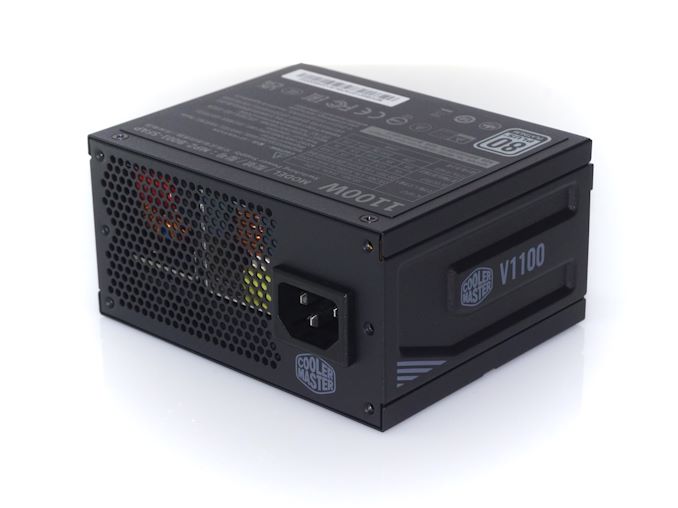
Cooler Master is a well-known brand in the PC hardware industry, offering a wide range of products including computer cases, cooling systems, and power supplies. With over 30 years of experience, the company has established itself as a reliable and innovative provider of PC components. In recent years, Cooler Master has been expanding its portfolio to include smaller form factor power supplies, known as SFX units, to cater to the growing demand for compact and portable gaming PCs.
Their latest offering in this category is the V SFX Platinum 1100, a powerful 1100-Watt power supply that also boasts an 80 Plus Platinum certification, ensuring high efficiency and lower energy consumption. Designed specifically for high-end gaming and workstation systems, the Cooler Master V SFX Platinum 1100 is a fully modular unit that can support multiple high-performance graphics cards, CPUs, and storage devices. Aside from its ludicrous power output for an SFX unit, the V SFX Platinum 1100 also brings ATX 3.0 compliance and has a 12VHPWR connector in SFX format. In this review, we will take a closer look at the V1100 SFX Platinum and evaluate its performance, design, and features.
| Cooler Master V SFX Platinum 1100W Power Specifications ( Rated @ 50 °C ) |
|||||
| RAIL | +3.3V | +5V | +12V | +5Vsb | -12V |
| MAX OUTPUT | 20A | 20A | 91.6A | 3A | 0.3A |
| 120W | 1099.2W | 15W | 3.6W | ||
| TOTAL | 1100W | ||||
| AC INPUT | 100 - 240 VAC, 50 - 60 Hz | ||||
| Street Price | $288 | ||||
Packaging and Bundle
Cooler Master supplies the V SFX Platinum 1100 in a sturdy and colorful cardboard box. The combination of vibrant colors certainly has the box standing out on a shelf and enough information about the PSU and its capabilities can be found on the sides and rear of the box. Inside the box, sizable packaging foam pieces protect the unit itself. With its dimensions and weight in mind, this packaging could withstand the harshest of shipping conditions.
Inside the box, we found a relatively basic but functional bundle. The company supplies the typical AC power cable, an ATX-to-SFX adapter, eight screws (four for the PSU and four for the adapter, if necessary), a few cable ties, and two cable straps. Considering the short cables this PSU has, these should be enough. We also received a manual and a leaflet with instructions concerning the 12VHPWR cable. Both are very detailed for end-user documentation, down to the pinout diagrams of the connectors. We should note that Cooler Master suggests that the 12VHPWR connector should be used for up to 30 connection/disconnection cycles.
The Cooler Master V SFX Platinum 1100 is a fully modular PSU and every cable can be detached, including the 24-pin ATX cable. All of the connectors and wires are black, with ribbon-like “flat” wires. The sole exception is the 12VHPWR cable, which is sleeved. The cables are shorter than those of an ATX PSU, which is a boon for those with smaller cases and compact systems where every millimeter counts, but it can be an issue if someone tries to install this unit inside a large ATX case using the adapter. Furthermore, the total number of connectors is rather small for a unit with that kind of power output.
| Cooler Master V SFX Platinum 1100 | ||
| Connector type | Hardwired | Modular |
| ATX 24 Pin | - | 1 |
| EPS 4+4 Pin | - | 1 |
| EPS 8 Pin | - | 1 |
| PCI-E 5.0 | - | 1 |
| PCI-E 8 Pin | - | 3 |
| SATA | - | 8 |
| Molex | - | 4 |
| Floppy | - | 1 |
The Cooler Master V SFX PLATINUM 1100 PSU
External Appearance
A mere glance at the Cooler Master V SFX Platinum 1100 reveals what an engineering feat this product truly is – the designing engineers managed to fit a platform capable of 1100 Watt continuous output and capable of excursions over 2000 Watts inside a standard 125 × 63.5 × 100 mm / 4.92 × 2.5 × 3.94 in (W×H×D) SFX form factor chassis. And let me reiterate that: that's the base SFX form factor, not the extended SFX-L form factor we typically see used for higher power units. The power-to-mass ratio of this unit is significantly greater than anything we've previously reviewed.
For the most part, the chassis of the V SFX Platinum 1100 is that of a standard SFX-sized unit that is sprayed with matte black paint. The company punched the left side of the unit with a geometric C-like shape, with the company and series logo printed in the middle. A large sticker with the unit’s certifications and specifications covers the top side of the chassis.
The rear side of the unit is fairly dull, home only to the necessary AC cable receptacle. There is no on/off switch as the designers of this unit needed every last bit of space they could get. The front side is densely populated with the connectors for the modular cables. The connectors are not color-coded but there is a basic legend printed on the chassis indicating what each connector is for. All of the connectors are keyed.
Internal Design
The 92 mm fan responsible for the cooling of the V SFX Platinum 1100 is made by Hong Hua (HA9215SH12FD-F00), an established manufacturer of quality products. It is a low-profile 15 mm thick fan with a very high current rating (0.46A) for its size. The maximum speed of 2800 RPM is high, but not unsurprisingly so for such a power-dense product and relative fan size. It has a fluid-dynamic bearing, which technically is a high-quality sleeve bearing. These last very long if not overstressed and will run significantly quieter compared to a typical ball bearing fans.
Although the design of the V SFX Platinum 1100 reminisces of CWT designs, the OEM behind its creation is a Taiwanese company named Sysgration. This is the first time we have encountered Sysgration as the OEM of a computer PSU, but Sysgration has been around for nearly 50 years, with a vast portfolio ranging from automotive electronics to battery systems. As a large percentage of the company is focused on energy systems, including on-grid and off-grid power products, their know-how of power electronics should not be underestimated.
The word “packed” does not suffice in describing the interior of the V SFX Platinum 1100. Whoever designed this unit is exceptionally good at making things fit (and we can only assume spent their youth mastering Tetris). The filtering stage starts on the back of the AC receptacle, consisting of four Y capacitors, three X capacitors, and two filtering inductors – a royal filter for a design where every bit of space counts. There is only one bridge rectifier, on its own heatsink. The heatsink is simplistic but has sufficient surface area and openings for airflow.
The APFC circuit is almost textbook, with the active components on the large heatsink across the edge of the PCB, one filtering coil and a single capacitor. One obvious difference here is that the huge 450V/800μF capacitor is placed sidewards, underneath the heatsink. The capacitor is made by EPCOS. On the primary side of the transformer, we find four primary side inversion MOSFETs that form the heart of an LLC resonant full-bridge design.
A vertical PCB on the secondary side of the transformer holds the ten MOSFETs that generate the main 12V line. We commonly find this practice on modern CWT designs, and now we see another manufacturer implementing it. This approach requires careful electrical and thermal design, as the secondary side MOSFETs essentially need to dissipate their thermal losses directly and/or via what tiny heatsinks can be attached to the vertical PCB. As with all modern PSU designs, the 3.3V and 5V lines are derived via DC-to-DC conversion circuits. All of the polymer capacitors are supplied by Nippon Chemi-Con and the few electrolytic capacitors are supplied by Rubycon.


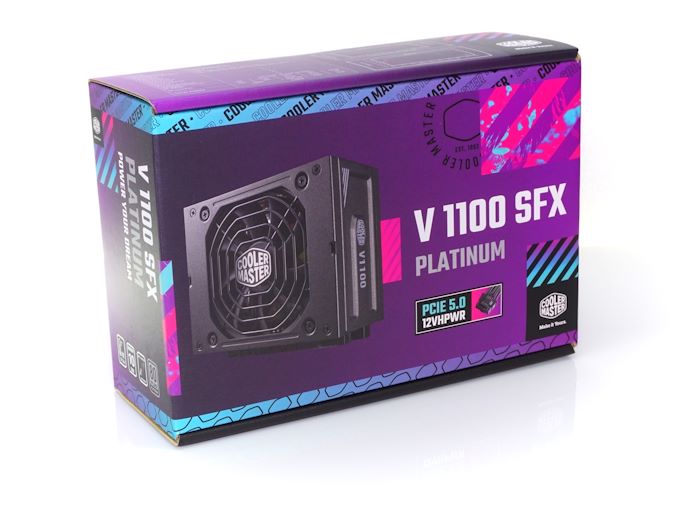
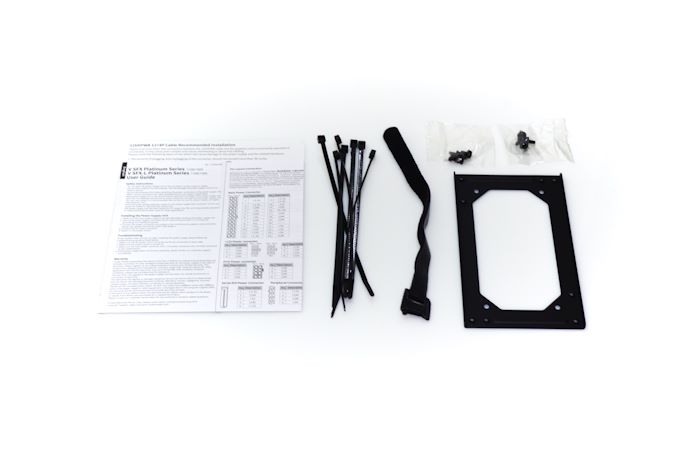
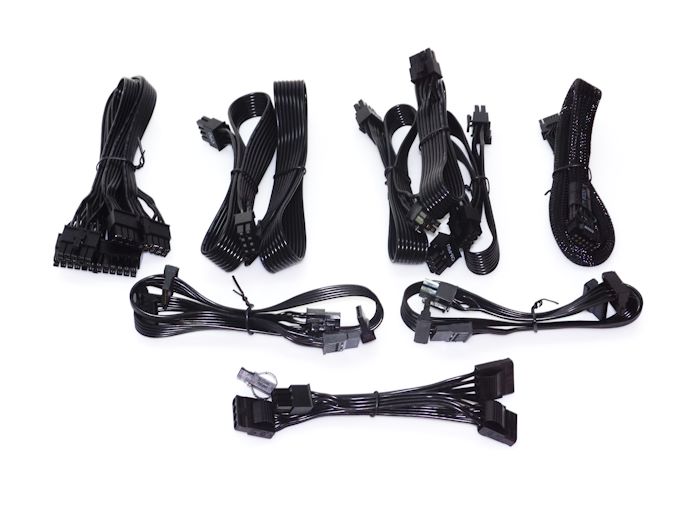
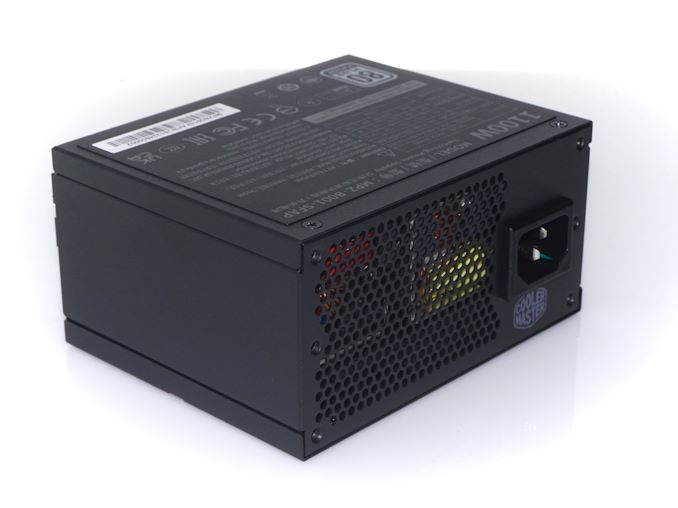

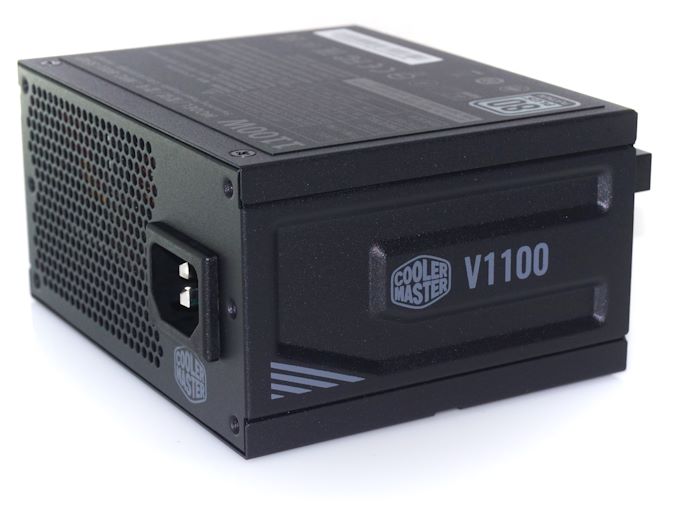
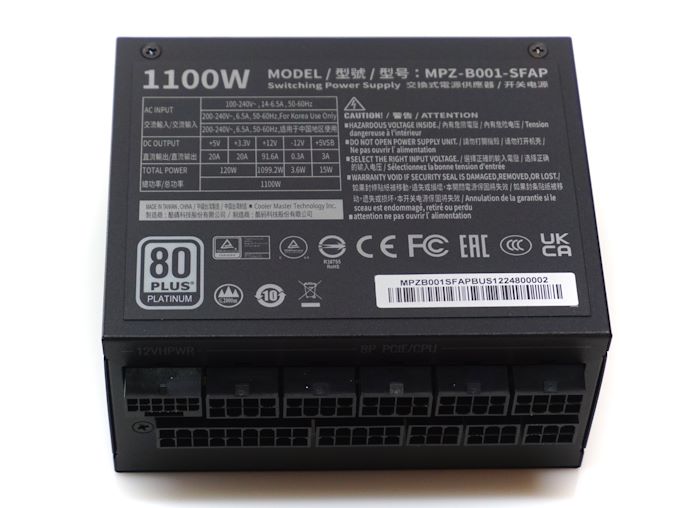
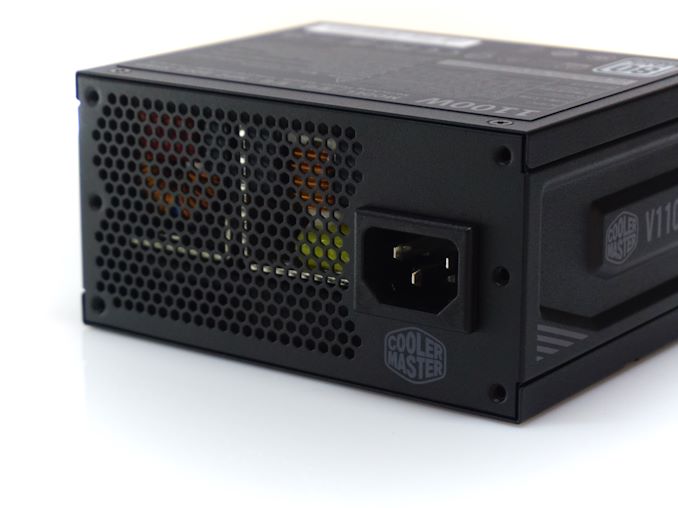
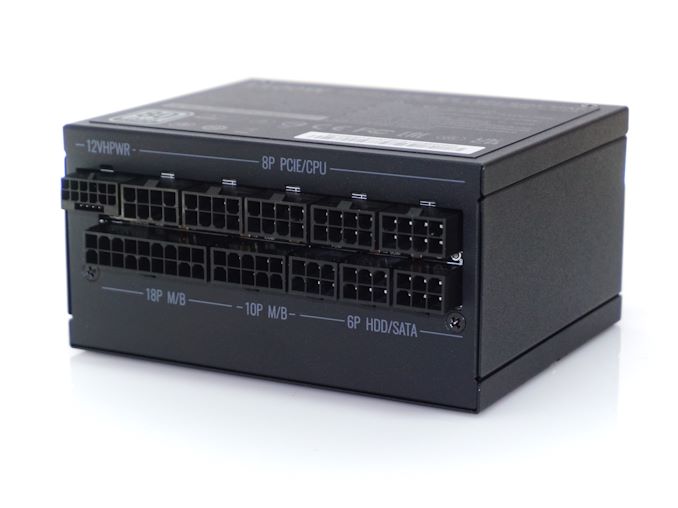
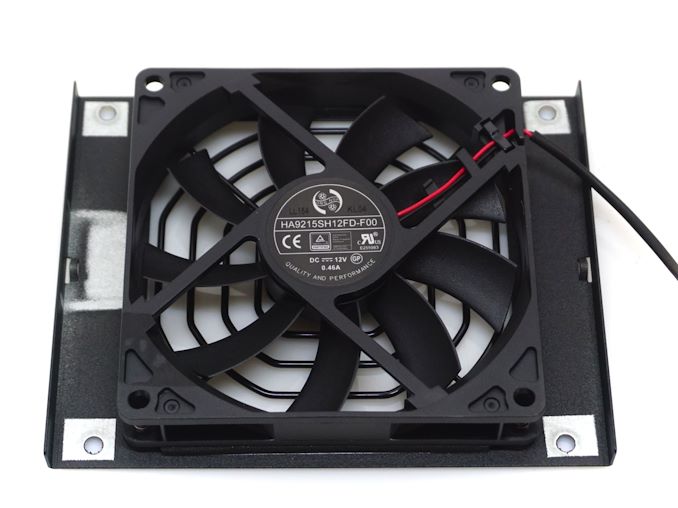
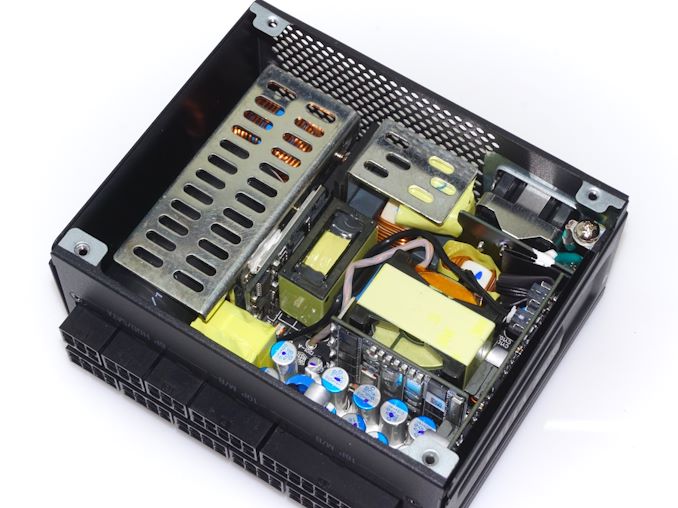
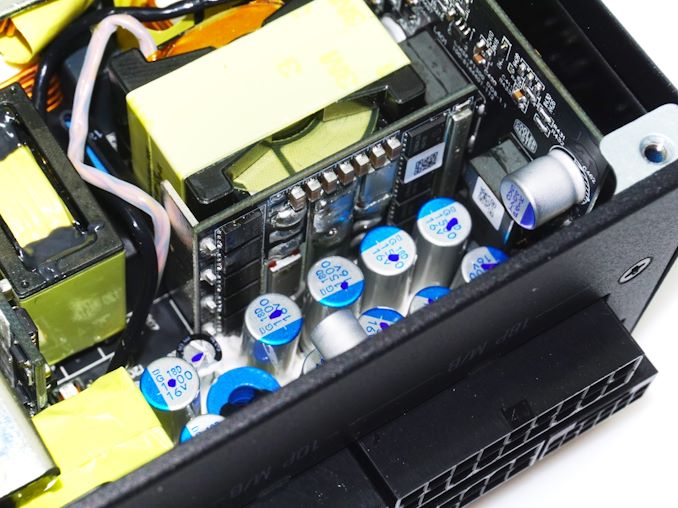
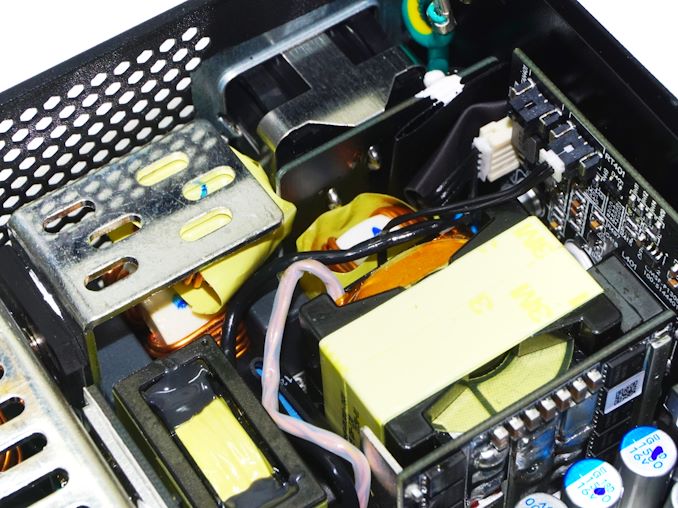
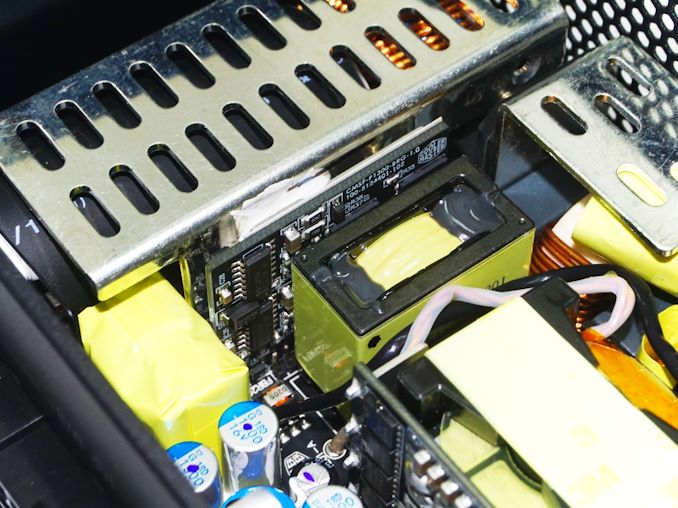
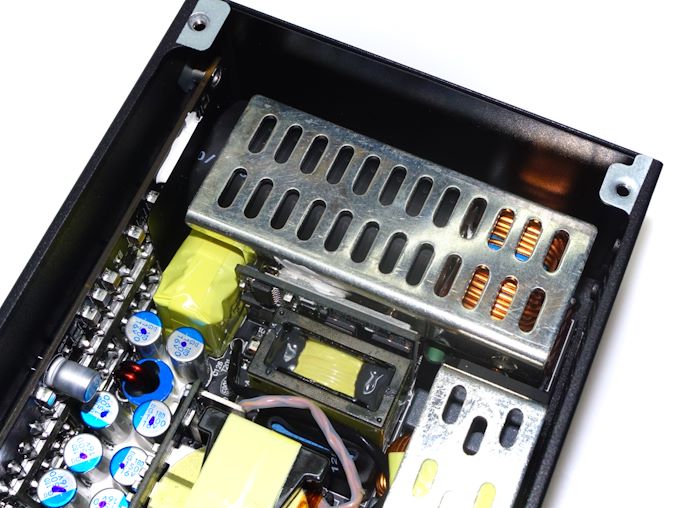








9 Comments
View All Comments
meacupla - Wednesday, February 22, 2023 - link
I am surprised they managed to get 1100W out SFX size constraints.Asus and Silverstone use SFX-L for their 1000~1200W range, and those already look cramped on the insides.
ZoSo - Wednesday, February 22, 2023 - link
I'm looking at this one and the Asus Loki 1000 to power a 4090FE and 13900k.TheinsanegamerN - Wednesday, February 22, 2023 - link
It looks great, but the cases that support SFX are so limited. Everyone is hung up on building oversized ITX boxes with ATX PSU support.Techie2 - Wednesday, February 22, 2023 - link
This looks like a decent 800w PSU design crammed into an SFX case. Without a 125mm fan it runs hopelessly hot and isn't practical for more than 800w max load. The excess ripple is also a concern. I personally would not buy this if I actually needed over 800w sustained power. I'm surprised Cooler Master didn't have the OEM work out a slightly better design even if they needed to use the SFX-L length. It's almost an excellent PSU but not at near max power.erinadreno - Thursday, February 23, 2023 - link
CoolerMaster IS the OEM for many other name-branded PSUs. It's either them or Greatwall for Tier 1 Chinese PSU OEMs.Techie2 - Thursday, February 23, 2023 - link
Quote from the review: "This is the first time we have encountered Sysgration as the OEM of a computer PSU..."Maksdampf - Wednesday, February 22, 2023 - link
Such a shame they did not go for the vastly superior SFX-L format. For 1,1KW it would have really made a difference and most SFX cases do support these the same way as short SFX PSUs. 120mm Fans do push 70% more air at the same speed and the slightly lengthened PCB would open op more airflow alleys.I got a good deal on a fractal Design Ion SFX (Seasonic Focus SGX clone) and even though it is a cheaper gold rated unit it has excellent noise and thermals. I could have gotten a more efficient corsair with its 92mm Fan, but i deliberately chose this one for the better thermals and noise.
lemurbutton - Thursday, February 23, 2023 - link
Anandtech will review power supplies, which are mostly all the same. But Anandtech still won't review M1 Ultra which is the most interesting piece of silicon to come out in decades.PeachNCream - Friday, February 24, 2023 - link
Have we been reading the same site? Anandtech is, at best, a shambling zombie of a website. There is news, but none of it is reported here. I have been waiting the past couple of months for the URL to redirect to Toms Hardware and I'm surprised it hasn't happened yet.